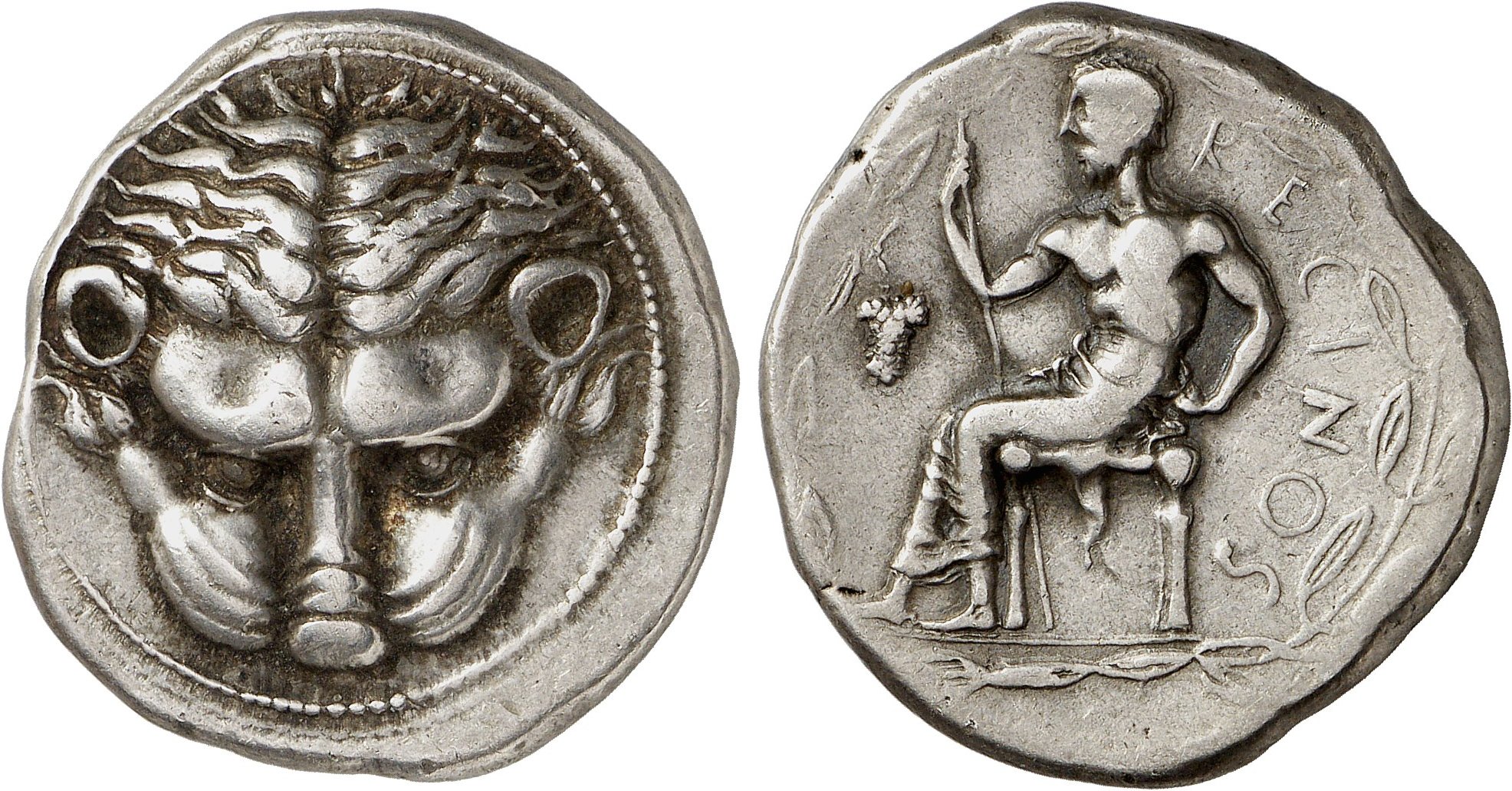Rhegium, silver, tetradrachms (466-415 BCE)
From SILVER
466 BCE - 415 BCE Silver 6,637 kg
Description
| ObverseInscription or printing placed on the obverse.: | Facing lion mask, olive spray to lower right, border dots |
| ReverseInscription or printing placed on the reverse.: | RECINON (Greek).Iokastos (or Aristaios?) seated left, holding scepter, RECI-N-OS around, all within wreath |
Mint and issuing power
| MintIdentifies the place of manufacture or issue of a numismatic object.: | Rhegium | Ancient regionAncient region.: | Modern countryModern country: Italy | AuthorityIdentifies the issuing power. The authority can be "pretended" when the name or the portrait of X is on the coin but he/she was not the issuing power. It can also be "uncertain" when there is no mention of X on the coin but he/she was the issuing power according to the historical sources: |
Chronology
| FromIdentifies the initial date in a range assigned in a numismatic context. | 466 BCE | toIdentifies the final date in a range assigned in a numismatic context.. | 415 BCE | PeriodTime period of the numismatic object.: Classical 480-323 BC |
Physical description
| MetalThe physical material (usually metal) from which an object is made.: | Silver |
Median weightMedian of the weights of numismatic objects (in grams). in grams | 17.15 | DenominationTerm indicating the value of a numismatic object. Examples: tetradrachm, chalkous, denarius.: | tetradrachm |
StandardStandard.: |
Image

AC 34 - Rhegium, silver, tetradrachm, 466-415 BC.jpg [1]
References
| Die study referencePublication of the study: | Herzfelder 19571Herzfelder 1957, first series | ||
| Coin series referenceReference to coin series study: | Sear I2Sear I, n° 498, RQEMAC3RQEMAC, n° 34, HN Italy4HN Italy, n° 2483, HGC 15HGC 1, n° 1633-1634 | ||
| Coin series web referenceCoin series web references: | |||
Obverse dies distribution
| FrequencyFrequency of specimen in distribution. ᵖ | Number of obversesNumber of obverse dies. ᵖ (o) | % (o) | Number of coinsNumber of coins. (n) | % (n) | Die nameName(s) of the die(s). |
| 1 | 2 | 10.53 | 2 | 1.09 | 29, 30 |
| 3 | 4 | 21.05 | 12 | 6.52 | 2, 4, 19, 20 |
| 4 | 2 | 10.53 | 8 | 4.35 | 18, 23 |
| 5 | 1 | 5.26 | 5 | 2.72 | 21 |
| 6 | 2 | 10.53 | 12 | 6.52 | 3, 5 |
| 8 | 1 | 5.26 | 8 | 4.35 | 34 |
| 10 | 1 | 5.26 | 10 | 5.43 | 22 |
| 15 | 1 | 5.26 | 15 | 8.15 | 35 |
| 16 | 1 | 5.26 | 16 | 8.7 | 28 |
| 19 | 2 | 10.53 | 38 | 20.65 | 27, 32 |
| 20 | 1 | 5.26 | 20 | 10.87 | 31 |
| 38 | 1 | 5.26 | 38 | 20.65 | 1 |
| Total | 19 of 19 | 99.99 | 184 of 184 | 100 |
Reverse dies distribution
no distribution is available
Quantification
| Number of obversesNumber of obverse dies. ᵖ (o) | 19 | Number of singletons (o1)The number of singleton coins. ᵖ | 2 |
| Number of reverse diesNumber of reverse dies. (r) | 31 | Number of coinsNumber of coins. (n) | 184 |
| Coins per obverse dieNumber of coins per obverse die. (n/o) | 9.68 | Coins per reverse dieNumber of coins per reverse die. (n/r) | 5.94 |
| Reverse per obverse ratioRatio of obverse dies divided by reverse dies. (r/o) | 1.63 | Percentage of singletons (o1)number of coins (n) divided by the number of singletons (o1) ᵖ | 10.53 % |
| Original number of dies (O) (Carter 1983 formula)The estimation of the number of coins according to Carter 1983 ᵖ | 19.35 | Coins struck if 20,000 as average productivity per dieCoins made if the average productivity for obverses (according to Carter) is 20,000. ᵖ | 387,000 |
| Original number of dies (O) (Esty 2011 formula)The estimation of the number of coins according to the singleton formula in Esty 2011 ᵖ (O) | 21.19 | Survival rate if 20,000 as average productivity per dieSurvival rate if average productivity is 20,000. ᵖ | 0.00048 |
| Coverage (o = % of O) (Esty 1984 formula)Esty 1984 - coverage (% of O) ᵖ (o = % of O) | 98.91% | Die productivity if survival rate 1/2,000Average productivity if survival rate is 1/2,000. ᵖ | 19,018.09 |
| Weight of silver (in kg) if 20,000 coins per die (O = Carter formula)Carter 1983 * Median weight * 20000 (*10 if gold or electrum) ᵖ | 6,637 kg <br /> 6,637 kg | Die productivity if survival rate 1/5,000Average productivity if survival rate is 1/5,000. ᵖ | 47,545.22 |
Remarks
References
- ^ Herzfelder, Hubert (1957), Les monnaies d’argent de Rhégion frappées entre 461 et le milieu du IVe siècle av. J.-C., Paris, 1957, 154 p., 20 pl.
- ^ Sear, David R. (1978), Greek coins and their values. Vol. I, Europe, London, xl, 316 p.
- ^ Callataÿ, François de (2003), Recueil quantitatif des émissions monétaires archaïques et classiques, Numismatique Romaine, Wetteren, VII + 267 p.
- ^ Rutter N. Keith et alii (eds.) (2001), Historia Numorum Italy, London, xvi, 223 p., 43 pl.
- ^ Hoover, Oliver D. (2018), The Handbook of Greek Coinage Series, Volume 1. Handbook of Coins of Italy and Magna Graecia, Sixth to First Centuries BC., Lancaster-London, 2018, lxi, 527 pages, 23 cm